Abstract
The chemical composition of formation waters within the upper basaltic crust were calculated or measured at 24 sites on the northwest portion of the Juan de Fuca (JDF) Plate using data from sediment pore waters, scientific boreholes, and seafloor springs. Formation waters differ in composition across this ridge-flank region because of variations in water-rock reactions and residence times, exchange rates with overlying sediment pore waters, and microbial processes along flow paths. We interpret spatial variations in the solute composition of formation waters to resolve areas that are geochemically distinct or similar, lateral trends that result from water transport, areas where water-rock reactions in the deeper crust are apparent, and sites of seawater recharge and formation water discharge. We provide evidence for large-scale lateral flow associated with two (mostly) buried basement ridges on ∼1.4 and ∼3.5 Ma seafloor, which are subparallel to the JDF spreading axis to the west. Between these two ridges, where the seafloor and the sediment-basement interface are relatively flat, formation waters have undergone extensive exchange with overlying sediment pore waters, consistent with a long residence time. Basaltic outcrops provide sites of seawater recharge and hydrothermal discharge, sometimes through the same feature, highlighting the heterogeneous nature of hydrogeologic conditions and processes. This work provides a blueprint for future plate-scale studies to assess, for example, geologic controls of crustal age, spreading rate, and sedimentation on subsurface hydrologic patterns.

